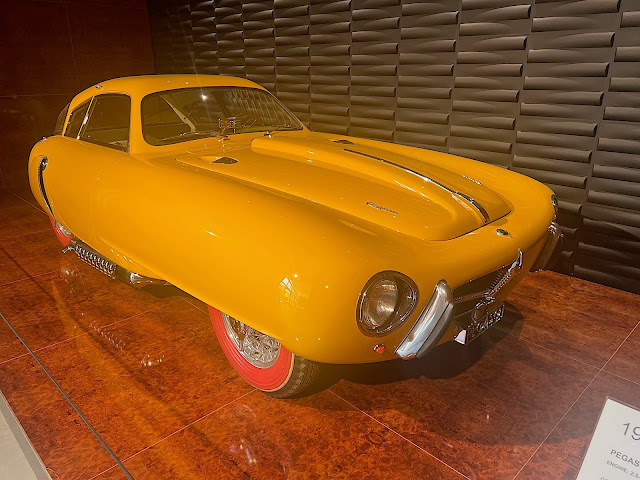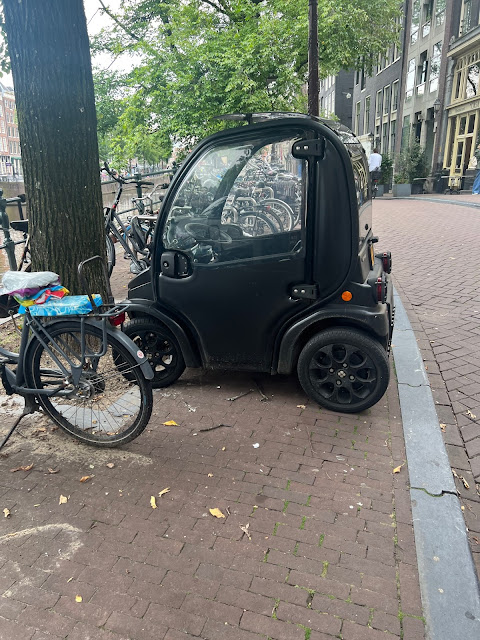We noted in Part 1 that the Louwman Museum had an near-overflowing collection of cars, and we covered only a small portion. We'd gotten as far as the 1970s, and so we'll start Part 2 there and then go back in time to provide a semblance of organization. Above, we see a trio of Alfa Romeo Type 33 artifacts. In the foreground, a 3 liter, 12-cylinder boxer Type 33/3 engine sits in front of a car it powered, the first of 4 Type 33/3 SC12 racers built with integral chassis structure (scatolato) rather than the previous tubular one. These last Type 33 cars were very successful, winning the World Sportscar Championships in 1975 & '77. Parked just behind the Type 33/3 is a Type 33/2 Daytona coupe from 1968. As is often true with Alfas, the name needs explaining. Though the engine is a 2-liter, 4-cam V8 designed by ex-ATS* and Ferrari engineer Carlo Chiti, the "/2" in the name refers not to the engine size, but tells us this is the uprated version of the 1967 Type 33 road racer. And "Daytona" refers to the car's 2 liter class victory in the 1968 Daytona 24 Hours. A Type 33/2 coupe co-piloted by Vaccarella and Zeccoli won the Imola 500 outright that year. Nino Vaccarella was a part-time racer and a full-time schoolteacher; somehow we needed to tell you that...
Staying for a moment with the Italians, we note the hovering presence of the Pinin Farina X* above. The famous coach builder enlisted aerodynamicist Alberto Morelli to come up with a fuel-efficient design minimizing aerodymanic drag, and the X, with its 4 wheels arranged in a diamond pattern in plan, emerged in 1960, the year before Pinin Farina became Pininfarina. A 43 hp Fiat 1100 engine angled to the car's centerline provided power to the single rear wheel (thus there's no differential) and the single front wheel steers. The drag coefficient was a low 0.23, and the fins (trendy in 1960) were there to provide directional stability.

Stability was not the main problem for Aston Martin's DB3 racer from 1951-'53, but speed was. The factory team road racers, of which this is one of 5, were routinely beaten by Jaguar's C-Type, so Aston uprated the car's engine from the 2.6 liter Lagonda 6 to a 2.9 liter before introducing the more aerodynamic DB3S with that engine in 1953. You may have thought this was one of those, as it lacks the flat sides of the DB3, and has something resembling the scooped front wheel wells of the DB3S. That's because it was re-bodied originally by the Aston team, seeking more speed. There were also 5 customer DB3 models sold, making the DB3 three times as rare as the more successful DB3S, of which Aston made 11 team cars and 20 customer cars by the end in 1956.
The museum's 1934 Chrysler CU Airflow 8 above, like the restyled Aston, was also an example of a design team seeking aerodynamic advantage, and resulted in increased speed as well as better fuel economy than the previous model. The wide body created more passenger space, but Carl Breer's wind-tunnel tested design encountered unexpected sales resistance while reducing wind resistance. Some of this may have been the result of introducing a car during an economic depression, when car sales were already low and unemployment at a near-record high. The Louwman's unrestored Airflow was one of few originally exported to Holland,and has never been repainted. The motorcycles in the foreground are a reminder that we still need to visit the microcar collection...
But not before having a look at some really big cars. Auburn-Cord-Duesenberg introduced the supercharged Duesenberg SJ above in a depression year as well; 1932 was also a bad year for sales, but the few who could afford this Lagrande Dual-Cowl SJ Phaeton would join an exclusive club including movie stars, jazz musicians and the King of Spain. The price of admission was $8,500 for the chassis and often $12,000 for the custom bodywork by the likes of Murphy, Rollston or Lebaron; that could buy as many as 40 Fords in 1932. The style of most of these bodies was rooted in the Twenties style of separate elements, not Thirties Streamline Moderne like the Airflow or Lincoln Zephyr, but the Duesey's engine was very modern for the time. The 7 liter inline 8 featured twin overhead cams and 4 valves per cylnder, and made 320 horsepower. Lagrande indeed...
We're sliding back in time, but not down in price class, to the year before World War 1. The Renault 22/24 CV Town Car with its expensive wicker-panelled bodywork by Muhlbacher (a Parisian coach builder, despite the name) powered its pampered occupants along the streets of Paris with a 5 liter, 4-cylinder engine with its radiator located between motor and driver's compartment, which led to the shovel-snouted profile that became famous in the terrible "war to end all wars", when Renault taxis transported soldiers to the front lines...
Automotive pioneer Panhard et Levassor built its fist "systeme Panhard" car in 1891: front engine driving rear wheels through a sliding-gear transmission. Eleven years later in 1912, coach maker Jean-Henri Labourdette built a stylish wooden skiff body on a Panhard & Levassor X19 and called it the Skiff-Torpedo. This design set a fashion for boat-tailed cars between the 2 world wars, when Labourdette would gain some fame for bodywork on Delage and Rolls-Royce chassis. The original was lost, but when in the 1970s the Louwman Museum decided to restore a deteriorated Panhard from the pre-WWI period with a replica Labourdette skiff, Jean-Henri Labourdette was happy to advise the museum on recreating one. It joined the Museum's collection of other pre-WWI cars and motorcycles...
At the end of Part 1 we mentioned the plethora of what are today called microcars on exhibit at the Louwman. Luckily, each car doesn't take up too much space, because the museum has an epic collection…
This green Hanomag Kommissbrot, made from 1924-'29 by a locomotive builder in Hannover, received the kommissbrot ("army loaf") nickname from a public experiencing hyperinflation, to whom the car's rounded, flush-sided lower body resembled loaves of bread issued to the army in the recent, vividly-remembered war. Because of the terrible economy, Hannoverische Maschinenfabrik AG made a car with minimal concessions to amenities or even safety; there was a single cylinder in the 500cc, 10 hp engine, a single headlight, and only a single brake drum to stop the car from its 60 kmh (37.3 mph) top speed. There was, however, a bit of extra ventilation afforded by the hinged windshield, which seems to lack a wiper…
The Standard Superior Type 2 was designed for the German Standard company by Josef Ganz. On a 78 inch wheelbase, it was powered by a rear mid-mounted 2-stroke inline twin just under 400cc in size, and advertised as a new "people's car" (volkswagen). In the year it appeared, 1933, more ominous developments in store for German industry were previewed when Hitler (who had his own "people's car" project in mind) forbade use of the volkswagen name in advertising by car manufacturers not long after taking power as Chancellor. Engineer Josef Ganz, forbidden to work as a German citizen of Jewish descent, fled to Switzerland...

There, he continued to pursue ideas explored in the Standard Superior (and later by VW in their Type 1 Beetle) including a backbone chassis and swing-axle rear suspension. By the late 30s he's built some prototypes with single-cylinder engines; by 1946 a firm called Rapid AG had built nearly 3 dozen prototypes without compensating Ganz for his ideas; the red car pictured above, next to the Standard Superior, is chassis #11. Ganz sued, but to no avail, and died in Australia in 1967. Czechoslovakian car builder Tatra had better luck suing VW over intellectual property theft, but that case dragged on until 1965, when VW paid Tatra one million DM.
Above we see a selection of the Louwman microcar collection, with a 1956 German Messerschmitt KR 200 cabin scooter in the foreground, featuring an aircraft-style canopy and 191cc two-stroke single cylinder powering the single rear wheel. Production began in 1955 and was just in time for the fuel shortages caused by the Suez crisis; around 12,000 were sold. There was no reverse gear; reverse motion was provided by reversing the engine rotation. Just above and to the right of the KR200 is a yellow electric Peugeot from 1941 (an answer to invasion-caused shortages) and in the upper left corner, the delightfully-named Frisky Family Three, a fiberglass-bodied 3-wheeler from 1960 styled by Michelotti and powered by a Villiers 2-stroke single-cylinder motorcycle engine. "Three" refers to 3 wheel, while "Family" optimistically suggests room for 2 adults and 2 children. No such claims were made for the red car that just squeezes into the bottom right above and is fully exposed below. Robert de Rovin had made motorcycles before Hitler's invasion of France in 1940; after war's end he introduced a series of microcars powered by single-cylinder and then twin-cylinder 4-stroke engines, with the envelope-bodied 2-cylinder D3 offering decent weather protection and power to match that of the Citroen 2CV. The line culminated with this 16 hp, 425cc D4, which despite offering more power than the 2CV in the same modern body as the D3, could not compete on price with the bigger, 4-passenger Citroen.
Rovin had introduced a single-cylinder D1 at the 1946 Paris Auto Salon, but that car was never produced in many examples. It was replaced by the D2 in autumn 1947 with 4-stroke twin replacing the D1 single cylinder, twin headlights instead of a single one, but the same charming, curvy styling. Sophisticated touches included an electric starter and rack & pinion steering. 200 specimens left the old Delaunay-Bellville factory before production gave way to the D3 with envelope body and actual doors in late 1948. Rovin exited the car business a decade later...
The egg-like three-wheeled Bambino below was produced under license to Germany's Fuldamobil, but despite the Italian name it was produced by Alweco in Veghel, Holland. With a 200cc, single-cylinder 2-stroke engine, it was not known for speed, but this 1955 model was in time for the Suez fuel shortage in '56...
By 1957, when a 4-wheeled Bambino Sport version was introduced, the public had moved on to other automotive offerings. A year later, Holland's DAF would introduce the DAF 600, the first production car with an infinitely variable automatic transmission using belt drives. The Variomatic was used by DAF and Volvo into the 1980s, but that's a story for another day...
Photo Credits:
All photos were generously supplied by longtime reader and contributor George Havelka. The monochrome shot of the Rovin D2 is from Wikimedia.
All photos were generously supplied by longtime reader and contributor George Havelka. The monochrome shot of the Rovin D2 is from Wikimedia.
*Footnotes:
The story of the car that presaged many aspects of Alfa Romeo's first Type 33, the ATS, was told in our post "Forgotten Classic Revival Show: ATS 2500GT and GTS", from Nov. 11, 2018. More details of the Pininfarina X, including its diamond wheel plan with zany angled engine, are shown in "Architect-Designed Cars: Part 2", posted May 21, 2017.
The story of the car that presaged many aspects of Alfa Romeo's first Type 33, the ATS, was told in our post "Forgotten Classic Revival Show: ATS 2500GT and GTS", from Nov. 11, 2018. More details of the Pininfarina X, including its diamond wheel plan with zany angled engine, are shown in "Architect-Designed Cars: Part 2", posted May 21, 2017.




















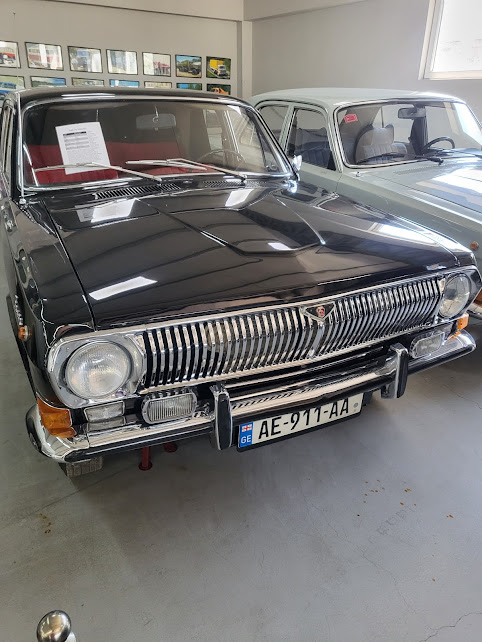










.jpg)






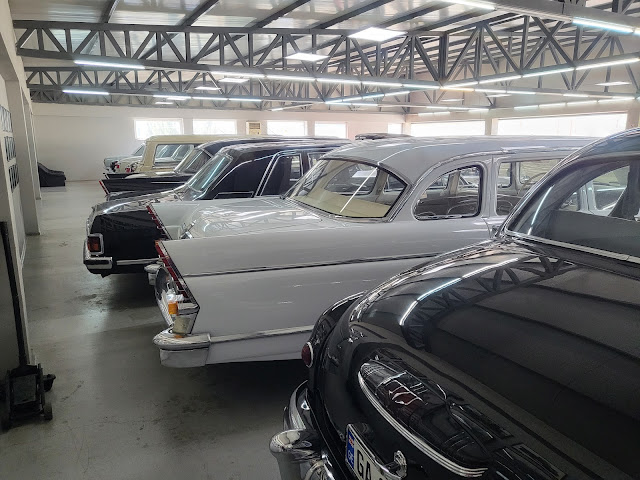

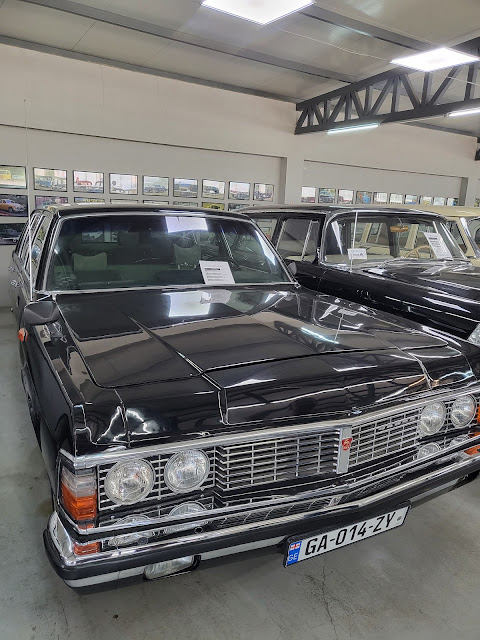

.jpeg)













